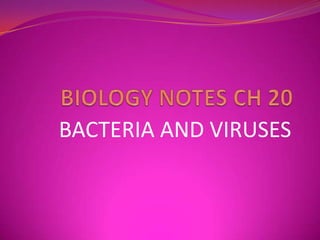
Chapter 20 notes
- 1. BIOLOGY NOTES CH 20 BACTERIA AND VIRUSES
- 2. I. BACTERIA Found everywhere on earth: mountains, hot springs, oceans, inside human body Bacteria are prokaryotes – a cell with no nucleus Bacterial structure: 1. single, circular strand of DNA 2. have cytoplasm 3. have cell membrane 4. have cell wall
- 3. Bacterial shapes 1. bacilli (bacillus) – rod shaped 2. spirilla (spirillum) – spiral shaped 3. cocci (coccus) – circular shaped
- 4. Classification – two kingdoms of bacteria: 1. Archaebacteria – ancient bacteria 2. Eubacteria– true bacteria Bacterial growth and reproduction 1. binary fission – a type of asexual reproduction where the bacteria splits in two. 2. conjugation – a type of sexual reproduction where two bacteria come together and exchange DNA. 3. some bacteria can form endospores to survive harsh conditions
- 5. Bacteria and disease 1. bacteria cause many diseases such as diphtheria, syphilis, cholera, Lyme disease, tuberculosis. 2. one of the most common bacteria is streptococcuspyrogenes which causes strep throat. 3. Salmonella – the bacteria that causes food poisoning in humans. 4. E. coli – bacteria that live in intestines, and are the source of many food poisoning outbreaks. 5. antibiotics – drugs that are used to treat bacterial infections.
- 6. Bacteria in our world 1. decomposers – bacteria that break down dead organisms 2. bacteria in the human intestines help in digestion and make vitamins 3. nitrogen-fixing bacteria help fertilize soil 4. bacteria are used in processing foods such as cheese, sour cream, yogurt, sauerkraut, vinegar 5. bacteria also assist in sewage treatment and copper mining 6. The simplest way to control bacteria is through sterilization with the use of heat or chemicals.
- 7. II. VIRUSES A virus is a nonliving particle that contains DNA or RNA and cannot live outside of a living cell. A virus reproduces by taking over a living host cell. The virus injects its DNA into the host cell and causes the cell to replicate more virus particles. The shape and composition of the virus determines which cells it will infect. Ex: HIV infects only white blood cells called T-cells.
- 9. Viral infections 1. lytic infections – the virus takes over the host cell and destroys it by causing the cell to burst. 2. lysogenic infection – the virus converts the host cell into a factory for making more of the virus.
- 10. Viruses and Disease 1. retrovirus – contain RNA instead of DNA. Ex: polio virus, HIV 2. Adenovirus – virus that causes colds, spread through the air. 3. Influenza – virus that causes flu; many different strains of this virus. 4. Herpes simplex virus – virus that causes herpes infections. 5. Bacteriophage – viruses that infect bacteria cells.
- 11. Vaccines – medicines used to prevent viral infections. 1. Edward Jenner – scientist who developed the first vaccine. He noticed that milkmaids who contracted the cowpox virus were immune to the smallpox virus. He used the cowpox virus to make a vaccine for smallpox. 2. The smallpox virus was completely eradicated (wiped out) through the worldwide use of vaccinations.